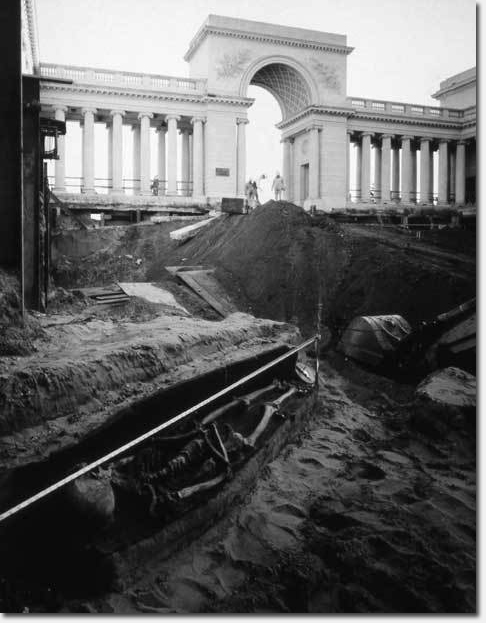
Photo by Richard Barnes
A share from the Western Neighborhoods Project today prompted us to re-post bits of past articles in honor of Halloween.
Many of you may know that the Richmond District was once THE place to be buried in San Francisco – there were several cemeteries in the neighborhood as far east as Laurel Heights and as far west as Lincoln Park. Beginning in the early 1900s and until the 1940’s, the cemeteries were decommissioned and the remains were moved out to Colma.
Well, most of them anyway.
In 1993, while the Legion of Honor Museum underwent renovations, construction workers came across remains of an estimated 700 bodies that had been buried in City Cemetery, a burial ground for ethnic and religious minorities, indigents and members of various benevolent associations.
More from the San Francisco History website:
In the summer of 1993, during renovation and expansion of the California Palace of the Legion of Honor, “about 300 corpses from the Gold Rush era—two of them still clutching rosaries, others were wearing dentures and Levis—were unearthed from what appears to be an old pauper’s graveyard. Some experts say another 11,000 bodies might lie underneath the museum grounds” according to a Los Angeles Times article (12 November 1993, A-23). The City Planner’s office has copies of the excavation activities. According to the archeaologist, there were over 700 individual coffin burials. All the remains and artifacts were turned over to the Coroner’s office (Medical Examiner).
The Medical Examiner’s office had the remains reburied at the Skylawn Cemetery in San Mateo, and the artifacts were given to the City Museum. Most of the finds were centered around the Legion of Honor’s courtyard. The archeaological firm proposed a more extensive dig, but the Museum felt it was out-of-scope of their activities, so they said no. Another interesting item was that an early resident, recalling the construction of the museum, mentioned that remains were found and put into a pit in one of the corners of the building, although she couldn’t recall which corner. So, it appears that remains are still there, somewhere.
Photographer Richard Barnes captured the eerie site and put on an exhibition “Still Rooms and Excavations” in 1997, telling SFWeekly, “It brought together all my interests: Here is the museum, archaeology, architecture, collecting…” See more photos from the exhibit on his website.
Local archaeologist Paula Frazer, who worked on the excavation, called the experience chilling and said it “was one of the spookiest archaeologist jobs I have worked on”. When the Legion was built from 1920 to 1924, the original contractors just plowed through burial sites, and plumbers laid pipes right through bodies and skeletons.
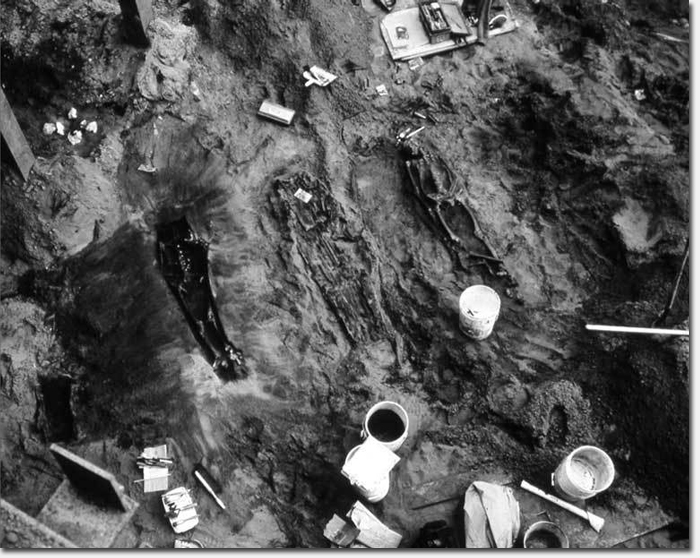
Photo by Richard Barnes
So if you feel a cold chill the next time you pass through the Legion of Honor galleries, don’t just chalk it up to the marble surround…
For more history on the cemeteries (and the neighborhood), we highly recommend the book San Francisco’s Richmond District by Lorri Ungaretti. You may also want to watch A Second Final Rest: The History of San Francisco’s Lost Cemeteries, a documentary by Trina Lopez which is available for rent at the SF Public Library Main Branch History Center.

Photo by Richard Barnes
Below are some interesting historical photos of the cemeteries from Lorri Ungaretti’s book. Happy Halloween everyone!
Sarah B.
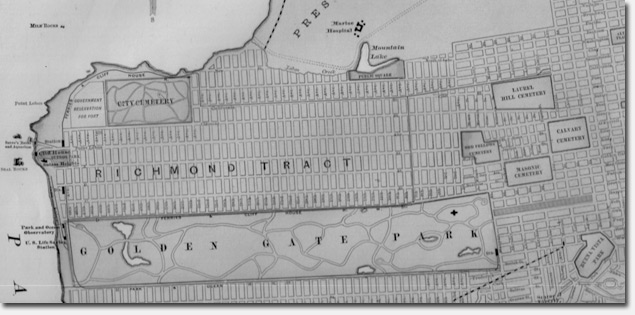
An 1891 map showing the five cemeteries in the northwestern part of San Francisco.
Note the City Cemetery in the upper left corner, and the the other four on the right side
(Laurel Hill Cemetery, Odd Fellows Cemetery, Masonic Cemetery, Calvary Cemetery).
Courtesy of Richard Brandi.
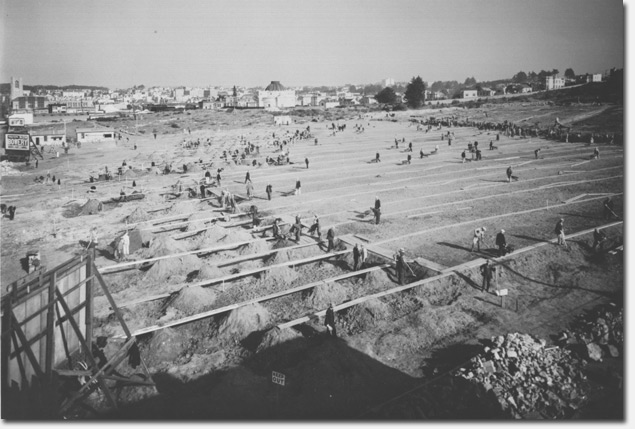
A crew works to remove the bodies from Odd Fellows Cemetery, December 26, 1933.
This is now the site of Rossi Playground.
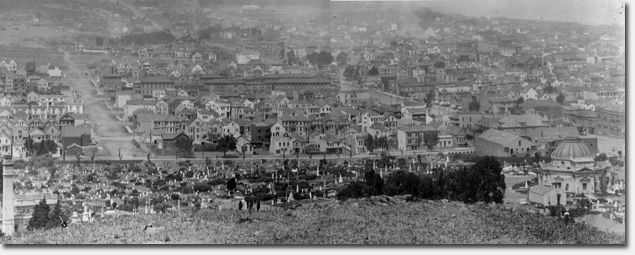
A panoramic view of Odd Fellows Cemetery. Note the Columbarium on the far right. On the very
far left edge, you can see the top of the crematorium. 1865.
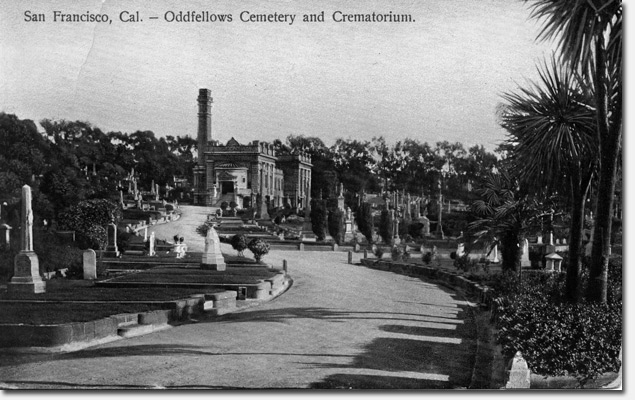
The Odd Fellows Crematorium building can be seen in the background. Remains were then inurned
in the Columbarium nearby. Courtesy of Glenn Koch.
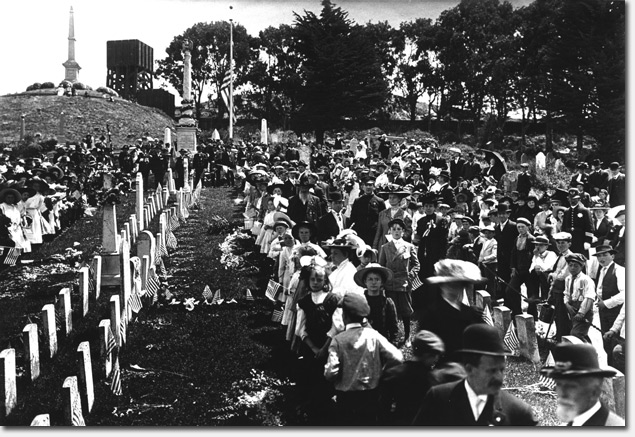
In the early years of San Francisco, there was little greenery or trees, so it was not unusual for residents
to flock to the cemeteries for recreation. This photo shows a Memorial Day celebration at
Laurel Hill Cemetery in 1909.
This makes me wonder about the reason for those noises I hear downstairs in the garage at times.
I’ve always thought the muffled voices I heard were from the neighbors next door, but perhaps they’re coming from under the concrete.
Nice article.
Thanks!
Here’s a song sung from the point of view of dead people who were forced to move to the Peninsula because of San Francisco’s real estate market Will Crain’s “That’s How We Ended Up In Colma”
https://soundcloud.com/willyray/thats-how-we-ended-up-in-colma
Local documentarian Trina Lopez explored this (and more) in great depth in her film “A Second Final Rest: The History of SF’s Lost Cemeteries.”
http://trinalopez.com/finalrest.html
Thanks, EB – that was mentioned in the article.
Sarah B.
“Whom” is buried? Parse the sentence and think about. Damn.
This is a great find for the third Matt Rommel adventure. Retired from the marine corps and the California department of corrections, Matt Rommel is the most formidable docent in the history of the Palace of the Legion of Honor. Look for “Beyond the Law” on Amazon in November.